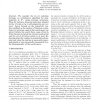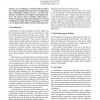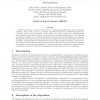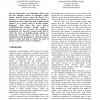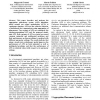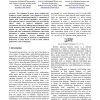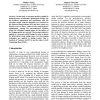82
Voted
CEC
2005
IEEE
15 years 6 months ago
2005
IEEE
A grouping genetic algorithm (GGA) for the university course timetabling problem is outlined. We propose six different fitness functions, all sharing the same common goal, and look...
86
Voted
CEC
2005
IEEE
15 years 6 months ago
2005
IEEE
We consider the (1+λ) evolution strategy, an evolutionary algorithm for minimization in Rn , using isotropic mutations. Thus, for instance, Gaussian mutations adapted by the 1/5-r...
66
Voted
CEC
2005
IEEE
15 years 6 months ago
2005
IEEE
An investigation is conducted into the effects of a complex mapping between genotype and phenotype upon a simulated evolutionary process. A model of embryogeny is utilised to grow ...
94
Voted
CEC
2005
IEEE
15 years 6 months ago
2005
IEEE
Abstract- Ant algorithms have generated significant research interest within the search/optimisation community in recent years. Hyperheuristic research is concerned with the devel...
75
Voted
CEC
2005
IEEE
15 years 6 months ago
2005
IEEE
Despite the existence of a number of procedures for real-parameter optimization using evolutionary algorithms, there is still a need of a systematic and unbiased comparison of di�...
82
Voted
CEC
2005
IEEE
15 years 6 months ago
2005
IEEE
Kondrashov and Kondrashov (2001) point out that, although common in population genetic models, epistatic systems where the fitness of a genotype is a non-linear function of the num...
78
Voted
CEC
2005
IEEE
15 years 6 months ago
2005
IEEE
Evolutionary Algorithms (EAs) are effective and robust methods for solving many practical problems such as feature selection, electrical circuits synthesis, and data mining. Howeve...
82
Voted
CEC
2005
IEEE
15 years 6 months ago
2005
IEEE
This paper describes and analyzes the aggregation pheromone system (APS) algorithm, which extends ant colony optimization (ACO) to continuous domains. APS uses the collective behav...
92
Voted
CEC
2005
IEEE
15 years 6 months ago
2005
IEEE
The evolution of music, from random note strings to certain “pleasant” note sequences, is traced in a multi-agent computational model. A community of agents, with some musical ...
101
Voted
CEC
2005
IEEE
15 years 6 months ago
2005
IEEE
In this study, a surrogate model is applied to multi-objective aerodynamic optimization design. For the balanced exploration and exploitation with the surrogate model, objective fu...

